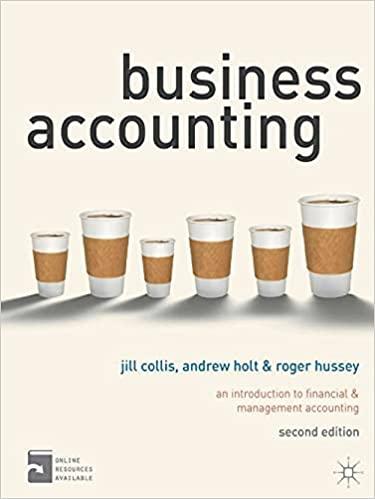
Craney Corporation makes one product and it provided the following information to help prepare the master budget for the next four months of operations: Giroleau Corporation has an activity-based costing system with three activity cost pools--Processing, Setting Up, and Other. The company's overhead costs, which consist of factory utilities and indirect labor, are allocated to the cost pools in proportion to the activity cost pools' consumption of resources. Costs in the Processing cost pool are assigned to products based on machine-hours (MHS) and costs in the Setting Up cost pool are assigned to products based on the number of batches. Costs in the Other cost pool are not assigned to products. Data concerning the two products and the company's costs and activity-based costing system appear below: Factory utilities (total) Indirect labor (total) $ 24,000 $ 3,000 The budgeted selling price per unit is $87. Budgeted unit sales for January, February, March, and April are 7,100, 8,300, 13,700, and 13,600 units, respectively. All sales are on credit The credit sales are collected as follows: 20% in the month of the sale and 80% in the following month. Craney wants the ending finished goods inventory to equal 40% of the following month's unit sales. Craney wants the ending direct materials inventory to equal 40% of the following month's direct materials production needs. Each unit of finished goods requires 5 pounds of material. The raw materials cost $1.00 per pound. Regarding raw materials purchases, 30% are paid for in the month of purchase and 70% in the following month. Each unit of finished goods requires 2.7 direct labor-hours. The direct labor wage rate is $19.00 per hour Distribution of Resource Consumption Across Activity Cost Pools: Processing Setting Up Other Factory utilities 30% 40% 30% Indirect labor 10% 40% 50% 700 Product S8 Product F1 Total MHS Batches 2,200 7,800 10,000 1,000 300 Sales (total) Direct materials (total) Direct labor (total) Product S8 $ 64,000 $28,000 $ 25,300 Product F1 $ 68,700 $ 19,800 $36,700 Required: a. What are the budgeted sales for February? b. What are the expected cash collections for February? c. According to the production budget, how many units should be produced in February? d. If 68,300 pounds of direct materials are needed for production in March, how many pounds of direct materials should be purchased in February! e. What is the estimated cost of direct materials purchases for February? f. If the cost of direct material purchases in January is $43,660, then in February what are the estimated cash disbursements for direct materials purchases? g. What is the total estimated direct labor cost for February? Required: a. Assign overhead costs to activity cost pools using activity-based costing. b. Calculate activity rates for each activity cost pool using activity-based costing. c. Determine the amount of overhead cost that would be assigned to each product using activity-based costing. d. Calculate the product margins for cach product using activity-based costing. Craney Corporation makes one product and it provided the following information to help prepare the master budget for the next four months of operations: Giroleau Corporation has an activity-based costing system with three activity cost pools--Processing, Setting Up, and Other. The company's overhead costs, which consist of factory utilities and indirect labor, are allocated to the cost pools in proportion to the activity cost pools' consumption of resources. Costs in the Processing cost pool are assigned to products based on machine-hours (MHS) and costs in the Setting Up cost pool are assigned to products based on the number of batches. Costs in the Other cost pool are not assigned to products. Data concerning the two products and the company's costs and activity-based costing system appear below: Factory utilities (total) Indirect labor (total) $ 24,000 $ 3,000 The budgeted selling price per unit is $87. Budgeted unit sales for January, February, March, and April are 7,100, 8,300, 13,700, and 13,600 units, respectively. All sales are on credit The credit sales are collected as follows: 20% in the month of the sale and 80% in the following month. Craney wants the ending finished goods inventory to equal 40% of the following month's unit sales. Craney wants the ending direct materials inventory to equal 40% of the following month's direct materials production needs. Each unit of finished goods requires 5 pounds of material. The raw materials cost $1.00 per pound. Regarding raw materials purchases, 30% are paid for in the month of purchase and 70% in the following month. Each unit of finished goods requires 2.7 direct labor-hours. The direct labor wage rate is $19.00 per hour Distribution of Resource Consumption Across Activity Cost Pools: Processing Setting Up Other Factory utilities 30% 40% 30% Indirect labor 10% 40% 50% 700 Product S8 Product F1 Total MHS Batches 2,200 7,800 10,000 1,000 300 Sales (total) Direct materials (total) Direct labor (total) Product S8 $ 64,000 $28,000 $ 25,300 Product F1 $ 68,700 $ 19,800 $36,700 Required: a. What are the budgeted sales for February? b. What are the expected cash collections for February? c. According to the production budget, how many units should be produced in February? d. If 68,300 pounds of direct materials are needed for production in March, how many pounds of direct materials should be purchased in February! e. What is the estimated cost of direct materials purchases for February? f. If the cost of direct material purchases in January is $43,660, then in February what are the estimated cash disbursements for direct materials purchases? g. What is the total estimated direct labor cost for February? Required: a. Assign overhead costs to activity cost pools using activity-based costing. b. Calculate activity rates for each activity cost pool using activity-based costing. c. Determine the amount of overhead cost that would be assigned to each product using activity-based costing. d. Calculate the product margins for cach product using activity-based costing







